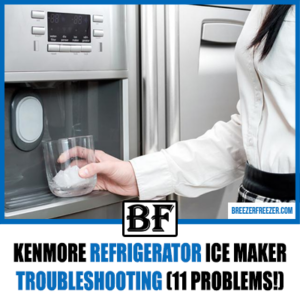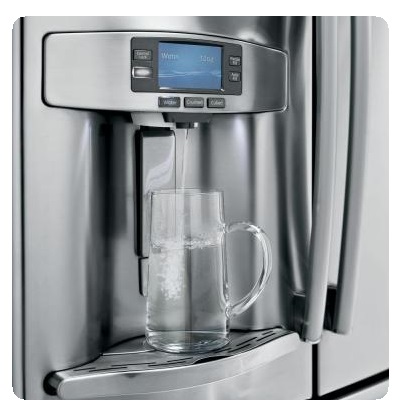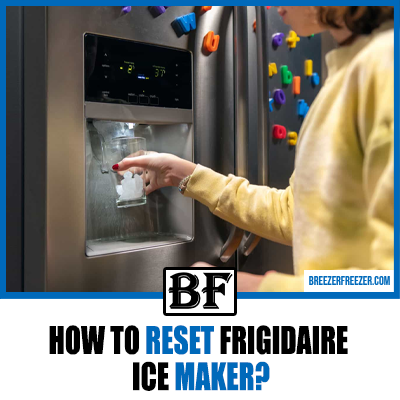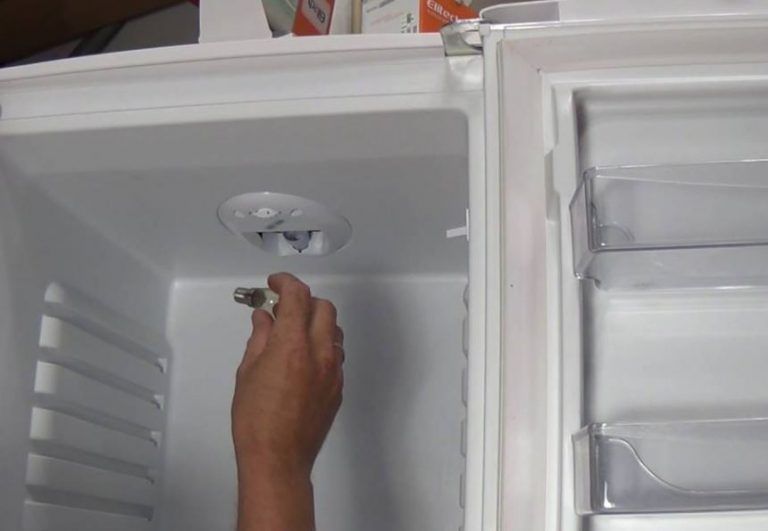Kenmore Refrigerator Ice Maker Troubleshooting (11 Problems!)

Kenmore refrigerators are generally reliable, but the ice maker component can sometimes cause issues.
This guide will help you troubleshoot common problems with your Kenmore refrigerator’s ice maker, such as it not turning on, not making or dispensing ice, leaking, freezing, overflowing, or not filling up.
It also covers issues like the ice maker producing smaller, discolored, or odd-tasting ice.
Kenmore Refrigerator Ice Maker Troubleshooting Guide
| Problem | Probable Cause | Solution |
| 1. Ice Maker Won’t Turn On | Child lock could be enabled or there might be a defect in the ice maker | Disable the child lock if turned on or substitute the faulty ice maker |
| 2. Ice Maker Fails to Produce Ice | Freezer could be warm, water pressure may be low, there may be a blocked filter, a ripped door gasket, or a defective ice maker switch, door switch, mold thermostat, ice level control board, or water inlet valve | Decrease freezer temperature (below 100F), boost water pressure to above 20 psi, and substitute the blocked filter, ripped door gasket or faulty switch, thermostat, control board, or water inlet valve |
| 3. Ice Maker Fails to Dispense Ice | There might be ice clumping, a frosty anger motor, or a faulty thermostat | Minimize the ice clumping, substitute the defective thermostat – consult an expert if the anger motor is frozen |
| 4. Ice Maker Works Slowly | There may be a blocked water filter, a warm freezer, or a defective water inlet valve | Substitute the blocked filter or defective inlet valve and decrease the freezer temperature if it’s above 100F |
| 5. Ice Maker Leaks | There could be ice clumping, fridge might not be level, or the fill valve may not be aligned | Minimize ice clumping, level the fridge, or adjust the fill valve if misaligned |
| 6. Ice Maker Freezes | Fridge temperature might be low or there could be a frosty water supply tube | Adjust the fridge temperature to between 1-40C or defrost the water supply tube |
| 7. Overflowing Ice Maker | Ice bin might be positioned incorrectly, the ice control arm could be damaged, or a shelf may be missing | Adjust the position of the ice bin and substitute the damaged control arm or missing shelf |
| 8. Ice Maker Not Filling Up | The water supply could be off, there could be a defective filter, inlet valve, motor, or control board, or a hose could be kinked | Turn on the water supply, remove any hose kinks or replace the faulty water filter, inlet valve, motor, or control board |
| 9. Smaller Ice Cubes | The water supply could be low or the freezer temperature may be high | Unblock the water supply line and decrease the freezer temperature |
| 10. Dirty/Discolored Ice | There could be a faulty inlet valve, a dirty ice mold tray, or a dirty supply line | Substitute the faulty inlet valve, clean the ice mold tray and supply line |
| 11. Odd-Tasting Ice | The water filter could be blocked, the ice bin might be dirty, the inlet valve could be blocked, or there could be spoiled food | Substitute the blocked water filter or inlet valve, clean the dirty ice bin, and remove the spoiled food |
Common Problems and Solutions
Ice Maker Does Not Activate
Typically there are two reasons why the ice maker does not turn on:
- Child Lock – If the “Child Lock” feature is enabled, the ice maker will remain inactive until it is deactivated. This safety feature is designed to prevent children from operating the ice maker.
- Defective Ice Maker – In some cases, the Kenmore ice maker fails to start due to a defect. If the issue is not related to the child lock, it is advisable to replace the ice maker.
Steps to replace a Kenmore refrigerator ice maker:
- Unplug the fridge and open the freezer compartment to remove the ice bucket.
- Loosen the mounting bucket to slide out the ice maker from the inside cradle.
- Slide in the replacement ice maker and secure it in position.
- Note: When dealing with a Kenmore Elite refrigerator, you may need to slide it out from beneath.
- Plug in the fridge and power on the ice maker.
Ice Maker Does Not Produce Ice
Sometimes the Kenmore ice maker turns on but fails to perform its primary function of producing ice. This issue can be attributed to the following:
- Warm Freezer – If the temperature in the freezer exceeds -12°C (or 10°F), the ice maker will not produce ice. Adjust the temperature to a recommended range of 0-10°F.
- Clogged Water Filter – If the water filter has been in use for more than six months, it may be clogged and obstructing water flow. Replace the water filter to ensure proper water supply.
- Faulty Door Gasket – A torn door gasket loses its ability to create sufficient suction, resulting in inadequate ice production. Replace the gasket if necessary.
- Defective Switches – Malfunctioning door or ice maker switches can prevent the ice maker from operating. Test the switches with a multimeter and replace any that are defective.
- Faulty Mold/Tray Thermostat – A faulty thermostat fails to regulate the temperature of the ice mold, leading to a halt in ice production. Test the thermostat with a multimeter and replace if necessary.
- Defective Ice-Level Control Board – If the ice-level control board is not receiving power, it should be replaced.
- Faulty Water Inlet Valve – A faulty water inlet valve disrupts the water supply to the ice maker. Test for continuity using a multimeter and replace the valve if needed.
- Low Water Pressure – Insufficient water pressure (below 20 psi) can hinder water supply to the ice maker. Adjust the water pressure within the range of 20-120 psi using a water pressure gauge.
Kenmore Elite Refrigerator’s Ice Maker Does Not Dispense Ice
When the ice maker in a Kenmore Elite refrigerator fails to dispense ice, it could be due to the following reasons:
- Ice Clumping – If ice clumps together, it can obstruct the dispensing mechanism. Allow the ice to melt or manually break up the clumps to resolve the issue.
- Frozen Auger Motor – The auger motor, located behind the freezing unit, may freeze and prevent ice dispensing. If this occurs, consult a refrigerator expert for assistance rather than attempting to defrost it yourself.
- Faulty Thermostat – A malfunctioning thermostat can hinder ice dispensing. Test the thermostat with a multimeter and replace it if it is found to be defective.
Ice Maker Producing Ice Slowly
Sometimes the ice maker in your Kenmore refrigerator may produce ice in small amounts or at a slow pace. Here are some possible explanations for this issue:
Clogged water filter: If the water filter is partially blocked with dirt, it can reduce water flow and result in slow ice production. In such cases, it is recommended to replace the water filter.
- Freezer temperature: Check the freezer temperature and adjust it to 0-50°F if it is higher than that. Maintaining the optimal temperature range promotes better ice production.
- Faulty water inlet valve: A faulty water inlet valve can restrict water flow and slow down ice production. If this is the case, the solution is to replace the faulty valve.
Ice Maker Leaking
If your Kenmore refrigerator’s ice maker is leaking, it could be due to the following reasons:
- Ice clumping: Excessive ice clumping can cause leaks. To resolve this, disconnect the ice maker and allow the ice chute to defrost naturally.
- Unleveled fridge: If the refrigerator is not stable and level, the ice can overflow and leak into the ice bin. Ensure that the refrigerator is properly leveled and stable to prevent this issue.
- Non-aligned fill valve: Check the fill valve and realign it if it is misaligned. A fill valve that is out of position can lead to ice leakage.
Frozen Ice Maker
The ice maker in your Kenmore refrigerator may freeze due to the following reasons:
- Low temperature: To prevent the ice maker from freezing, maintain a freezer temperature between 0-50°F and a fridge temperature between 33-40°F.
- Frosty water supply tube: If the water supply tube is frozen, it can cause the ice maker to freeze as well. Use a hairdryer to run warm air through the tube and defrost it.
Overflowing Ice Maker (Excessive Ice)
If your ice maker is overflowing with ice, consider the following possibilities:
- Improperly positioned ice bin: An incorrectly positioned ice bin can misdirect newly produced ice, making it appear as if the ice maker is overflowing. Ensure that the ice bin is correctly positioned.
- Broken ice control arm: A broken ice control arm fails to stop the ice maker from producing more ice, leading to overflow. Replace the broken ice control arm to resolve the issue.
- Missing shelf: In some cases, the absence of a shelf can cause ice to overflow. Contact the manufacturer for a replacement shelf if needed.
Ice Maker Not Filling Up
If your ice maker is not filling up with water, consider the following possibilities:
- Water supply turned off or blocked/kinked: Ensure that the water supply line is turned on and free from any blockages or kinks. These issues can prevent water from reaching the ice maker.
- Faulty filter, water inlet valve, control board, or motor: If the filter, water inlet valve, control board, or motor is faulty, it can affect the ice maker’s ability to fill up with water.
Smaller Ice Cubes
Kenmore ice makers are not designed to produce tiny ice cubes. If you notice smaller ice cubes being produced, consider the following factors:
- Low water supply: Insufficient water supply can result in the production of smaller ice cubes. Check for any kinks or blockages in the water supply line and ensure proper water flow.
- Higher temperature: Maintain the freezer temperature within the range of 0-50°F and the fridge temperature between 33-40°F for optimal ice production.
Dirty/Discolored Ice
If the ice produced by your Kenmore ice maker appears dirty or discolored, consider the following possibilities:
- Faulty water inlet valve: A malfunctioning inlet valve can contaminate the ice water, leading to discolored ice. If the valve shows no continuity, it may need to be replaced.
- Dirty ice mold tray: If the ice mold tray is cloudy or dirty, it can affect the quality of the ice. Clean the tray thoroughly to ensure clean ice production.
- Dirty supply line: A dirty supply line can introduce impurities into the ice-making process. If you suspect a clog, try cleaning the supply line. If the issue persists, contact your local water supplier to address any problems at the source.
Odd-Tasting Ice
If the ice produced by your Kenmore refrigerator’s ice maker has an unpleasant taste, consider the following possibilities:
- Clogged water filter or valve: Dust, dirt, and microbes can accumulate in the water filter, affecting the taste of the ice. Replace the water filter if it is clogged or obstructed.
- Dirty ice bin: Check the ice bin for any dirt or residue that could be causing the odd taste. Clean the bin thoroughly to ensure better-tasting ice.
- Spoiled food: Dispose of any spoiled or expired food items in the freezer. Lingering odors from spoiled food can transfer to the ice, resulting in an unpleasant taste.
Resetting Your Kenmore Ice Maker
If you need to reset your Kenmore ice maker, remove the front plate covering the ice maker, locate the on/off switch and turn it off. Unplug the fridge for 5 minutes, then plug it back in and turn the switch on before replacing the front plate.
Remember, if these DIY solutions don’t resolve the issue, it’s recommended to consult a professional for further assistance.





